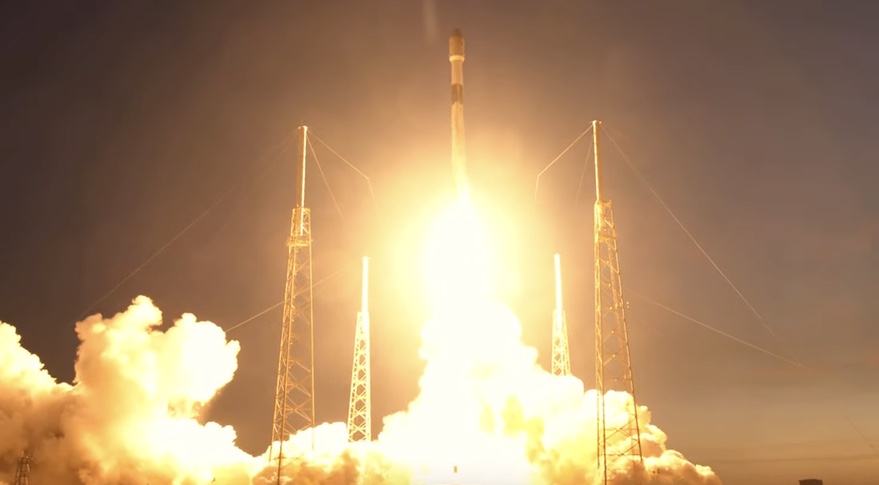WASHINGTON — A SpaceX Falcon 9 placed an Italian radar mapping satellite into orbit Jan. 31 after four days of delays caused by range and weather problems.
The Falcon 9 lifted off from Space Launch Complex 40 at Cape Canaveral Space Force Station in Florida at 6:11 p.m. Eastern. The rocket’s upper stage deployed its payload, the Cosmo-SkyMed Second Generation (CSG) 2 satellite for the Italian space agency ASI and the Italian military, an hour after liftoff.
The rocket’s first stage made a landing back at Landing Zone 1 at Cape Canaveral eight minutes after liftoff. The booster was originally built as a side booster for the triple-core Falcon Heavy rocket and flew on the second and third Falcon Heavy missions in 2019. This was the first launch where a Falcon Heavy side booster had been converted into a Falcon 9 booster.
The launch was originally scheduled for Jan. 27 but was scrubbed by poor weather, which also postponed launch attempts the next two days. Weather cooperated for a fourth attempt Jan. 30, but a cruise ship sailed into restricted waters off the Florida coast and could not move out of the way in time for the launch.
The 2,200-kilogram satellite, built by Thales Alenia Space, is the second in a fleet of four satellites intended to replace the original Cosmo-SkyMed satellites launched between 2007 and 2010. The second-generation satellites provide X-band synthetic aperture radar imagery, like the first-generation satellites, but can also collect images of two regions hundreds of kilometers apart simultaneously.
CSG-2 was originally slated to launch on a Vega C. However, with the first launch of that vehicle delayed until at least May, ASI elected last fall to move the launch to a Falcon 9 in the hopes of launching the spacecraft by the end of the year, a decision that raised eyebrows among some in the in the European space industry.
“Since Arianespace backlog was already full on Soyuz and Ariane systems in 2021, it was not possible to have a European back-up solution compliant with the CSG-2 schedule,” ASI said in a statement last fall justifying its decision to acquire a launch from SpaceX. “In line with its long-lasting support ensured to the European launch industry, ASI confirmed its trust in Arianespace and Vega C capabilities by contracting the launch of the CSG-3 satellite, planned for 2024.”
High launch cadence
The launch is the fourth Falcon 9 mission of 2022, after two Starlink launches Jan. 6 and Jan. 18 and the Transporter-3 rideshare mission Jan. 13. Another Falcon 9 launch of Starlink satellites is scheduled for no earlier than Feb. 1 from the Kennedy Space Center, while a Falcon 9 will launch a classified payload for the National Reconnaissance Office from Vandenberg Space Force Base in California Feb. 2.
While SpaceX executives have not disclosed a specific forecast of the number of launches scheduled for this year, Sandy Magnus, a member of NASA’s Aerospace Safety Advisory Panel, said at a meeting of the committee Jan. 27 that the company was planning for 52 launches in 2022, or one per week.
“That’s an incredible pace,” she said, but injected a note of caution. “NASA and SpaceX will have to ensure the appropriate attention and priority is focused on NASA missions and the right resources are brought to bear to maintain that pace at a safe measure.”
However, SpaceX has struggled to maintain a high launch cadence in the past. In 2021, the company performed 20 launches in the first six months, but then only three in the next four months, in part because of delays in the development of Starlink satellites that constitute the majority of the Falcon 9 manifest.
SpaceX did pick up the pace in the final two months of the year, including three launches within 72 hours in December. It finished the year with 31 launches, a record for the company.
That pace will be governed both by the availability of payloads as well as the ability of SpaceX to refurbish Falcon 9 first stages and build new upper stages. In a podcast in December, SpaceX Chief Executive Elon Musk suggested his company’s current pace of refurbishment was falling short of his goals. “The booster is not as rapidly and completely reusable as we’d like, and nor are the fairings,” he said.
In the same podcast, he offered an estimate of the cost of a Falcon 9 launch. “Our minimum marginal cost, not counting overhead, per flight is on the order of $15–20 million,” he said, with the bulk of that cost going to the upper stage, which he estimated at $10 million.
“That’s extremely good. It’s by far better than any rocket ever in history,” he said, but that the full reusability promised by SpaceX’s next-generation Starship vehicle will significantly reduce that cost while increasing payload capacity. “Starship, in theory, could do a cost per launch of a million, two million dollars, or something like that, and put over 100 tons into orbit. This is crazy.”
